News
2025
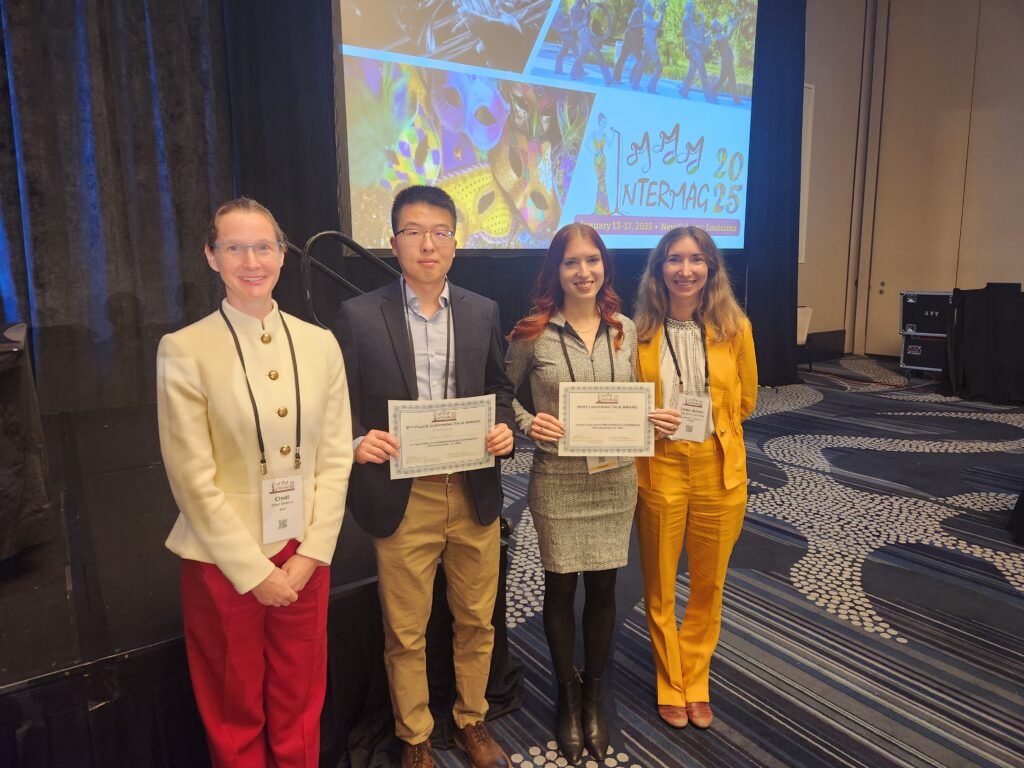
Hugh Chen Won Lightning Talk Award at 2025MMM-Intermag (1/2025)
Congratulations to Hugh, who was selected as 2nd place winner in the Young Professional Lightning Talk Competition at the recent 16th Joint MMM-Intermag Conference held in New Orleans. This recognition celebrates Hugh’s exceptional ability to present complex research in under two minutes. Their award-winning presentation, titled “All Nitride Magneto-Ionics,” highlights groundbreaking work focused on developing novel materials to enable energy-efficient magnetic devices. The joint MMM-Intermag Conference, sponsored by the AIP Publishing and the IEEE Magnetics Society, brings together leading researchers from around the world to share cutting-edge advancements in the field of magnetism.
2024
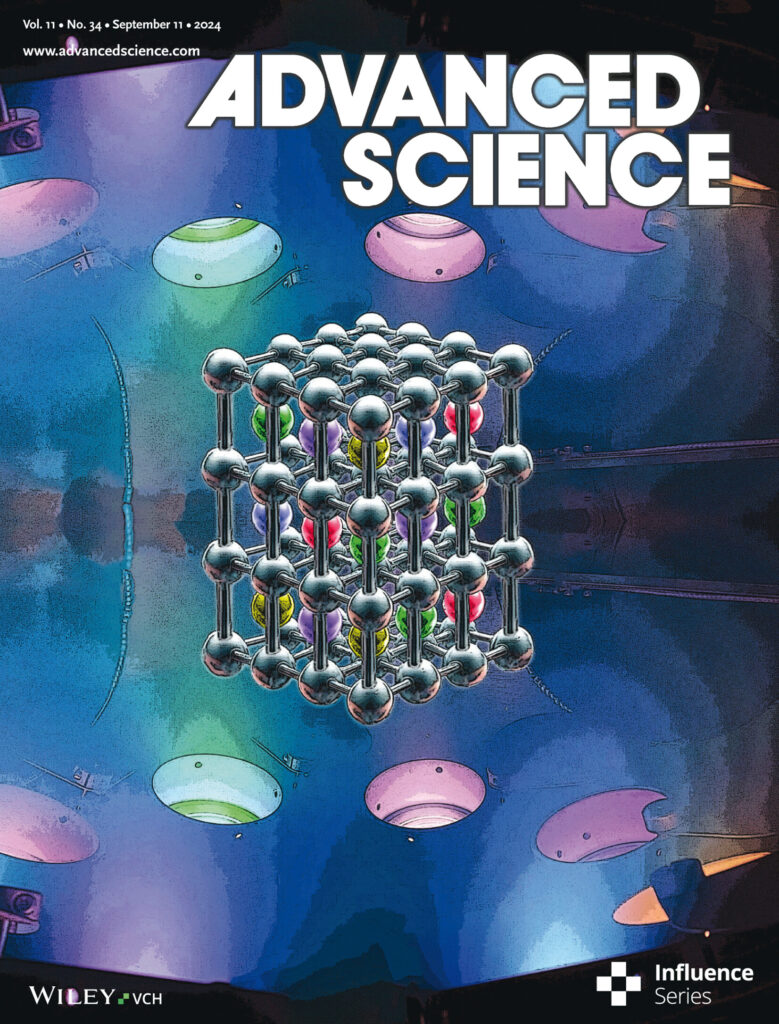
“Spotlight” on Magnetic High Entropy Alloys (9/2024)
The vast high entropy alloy (HEA) composition space is promising for discovery of new material phases with unique properties. Using multi-source magnetron sputtering, Willie has achieved high entropy alloy thin films of FeCoNiCuMn on suitable substrates, and induced large strain in the films using rapid thermal annealing. This approach resulted in the formation of a single crystalline phase and a 40 fold increase in coercivity, indicating a significant magnetic anisotropy not seen in the bulk material. Additionally, the inclusion of Pt in the films led to the formation of a highly ordered L10 single phase after rapid thermal annealing. This new phase exhibits a high magnetic anisotropy and a coercivity increase by three orders of magnitude compared with the fully disordered state. These results demonstrate a promising HEA approach to achieve high magnetic anisotropy materials using RTA. The paper is published recently in Advanced Science and featured on the journal cover.
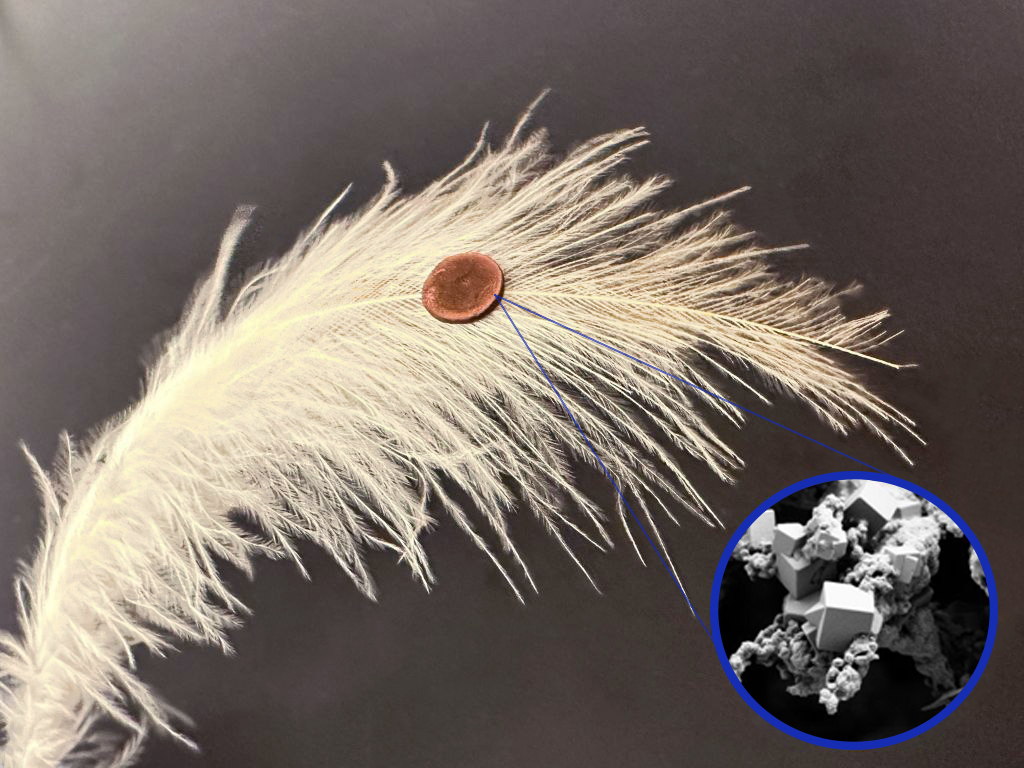
Particulate Filtration using Multifunctional Metallic Nanowire Foams (8/2024)
In this study led by James Malloy, a multifunctional filtration platform is demonstrated using porous metallic nanowire foams that are efficient, robust, antimicrobial, and reusable, with the potential to guard against multiple hazards. The complex 3D foam microstructures are also investigated, and their correlation with the filtration performance is revealed. These results are recently published in the journal Nanoscale.
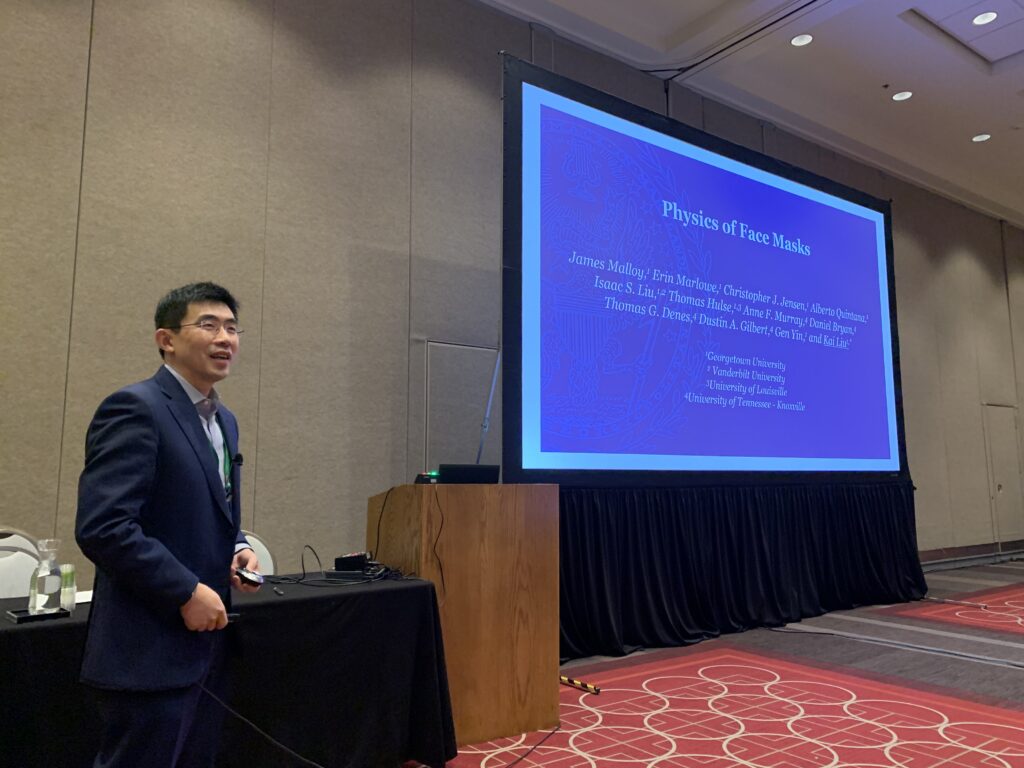
Prof. Liu delivered invited talk at the 2024 APS March Meeting (3/2024)
Prof. Liu was invited to deliver a talk on “Physics of Physics Masks”, as part of the 2024 APS March Meeting Invited Symposium on “Physics for Everyone”. He reviewed the development of the nanoporous foams, the Mask Innovation Challenge, and the current status of the project.
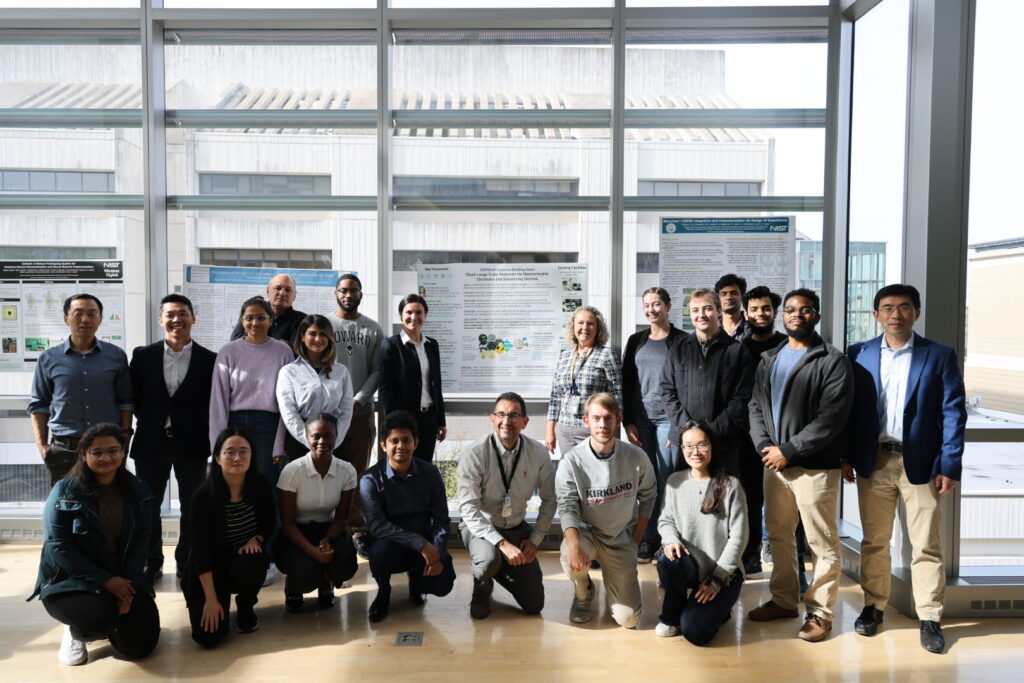
New DEPSCoR Grant to Support Neuromorphic Computing Efforts at DC Universities (2/2024)
We are happy to be part of a team from DC universities led by George Washington University that has recently received a $1M Defense Established Program to Stimulate Competitive Research (DEPSCoR) capacity-building grant from the Department of Defense , “Short-range Order Materials for Neuromorphic Electronic and Biosensing Devices”. Our team will collaboratively develop the regional research capacity needed to create new types of devices for next-generation computing. In particular, we will focus on emerging materials and devices for future integration in brain-inspired computing systems.
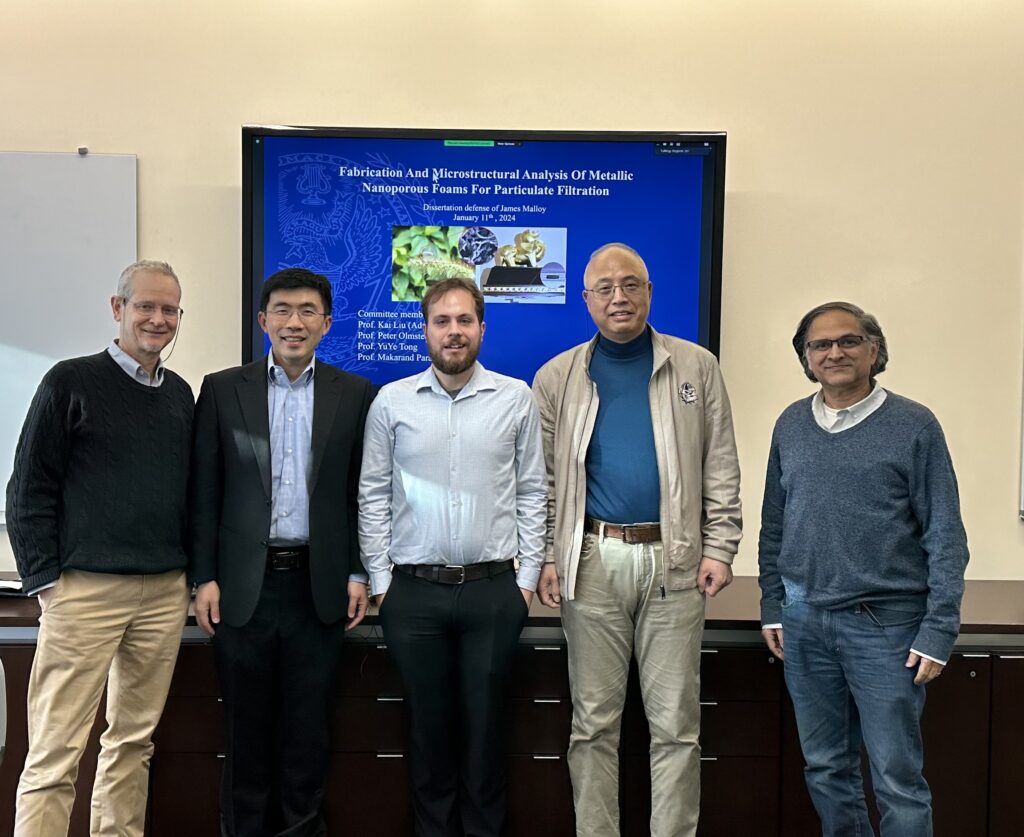
Congratulations to Dr. James Malloy (1/2024)
Congratulations to James Malloy, who has successfully defended his Ph.D. thesis on “Fabrication and microstructural analysis of metallic nanoporous foams for particulate filtration” with distinction! James has single-handedly carried out this original research on using light-weight nanoporous metallic nanowire foams for filtration. This is a new area outside of our traditional focus. He excelled at “pushing the envelop” on all fronts and building up our facilities from scratch. His work has been highly impactful, garnering many awards.
2023
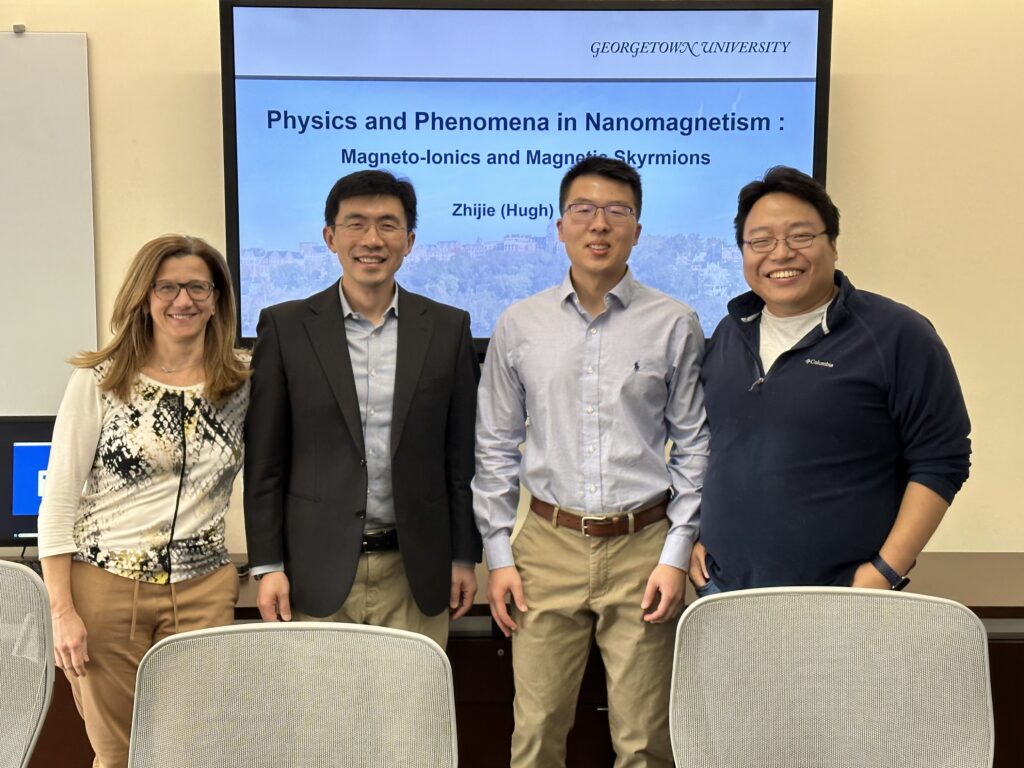
Congratulations to Dr. Hugh Chen (11/2023)
Zhijie (Hugh) Chen has successfully defended his Ph.D. thesis on “Physics and Phenomena in Magnetism at the Nanoscale” with distinction! Hugh has made important contributions to a variety of topics in nanomagnetism and spintronics, particularly in all-nitride magneto-ionics and topological spin textures such as magnetic skyrmions and domain walls. He is also indispensable in the lab, instrumental in moving our lab from UC Davis and restarting at GU, and in the daily maintenance of the lab. Congratulations on a job extremely well done!
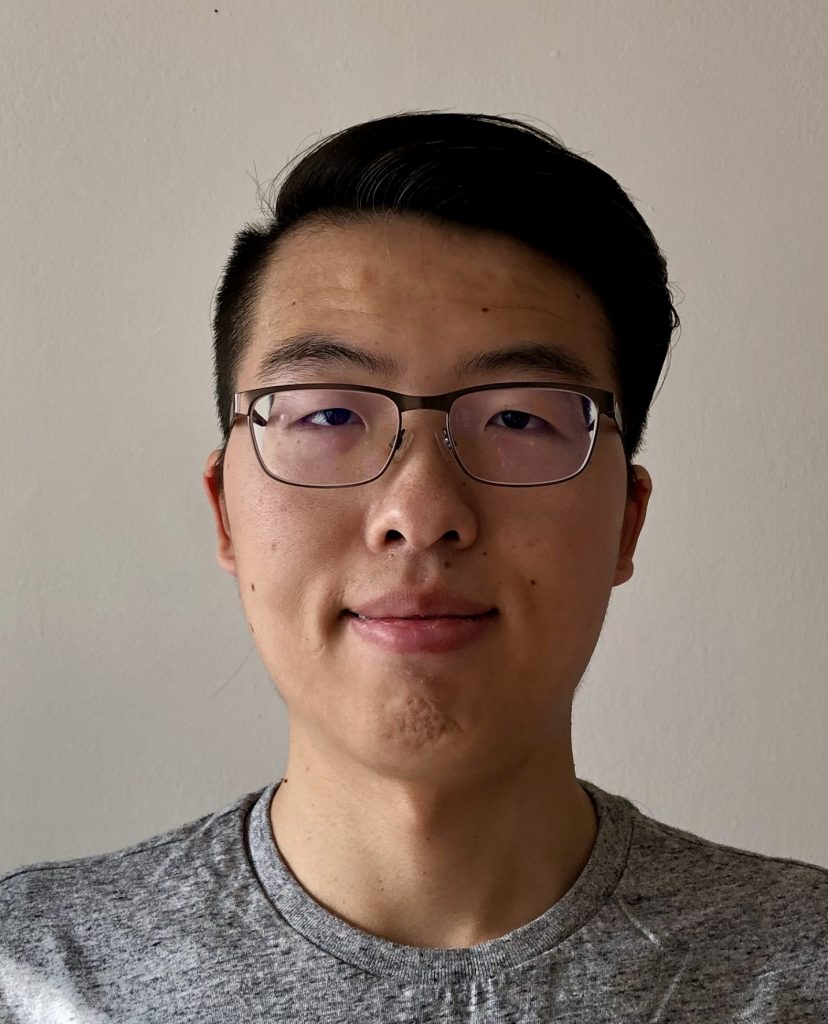
All-nitride magneto-ionics demonstrated (8/2023)
Ferrimagnets have received renewed attention as a promising platform for spintronic applications. Of particular interest is the Mn4N of the manganese nitride as an emergent rare-earth-free spintronic material. In this paper led by Hugh and just published in Applied Physics Letters, we report the realization of high-quality (001)-ordered Mn4N thin film by sputtering Mn onto Mn3N2 seed layers on Si substrates. As the deposited Mn thickness varies, nitrogen ion migration across the Mn3N2/Mn layers leads to a continuous evolution of the layers to Mn3N2/Mn2N/Mn4N, Mn2N/Mn4N, and eventually Mn4N alone. The ferrimagnetic Mn4N indeed exhibits perpendicular magnetic anisotropy, and forms via a nucleation-and-growth mechanism. The nitrogen ion migration is also manifested in a significant exchange bias, due to the interactions between ferrimagnetic Mn4N and antiferromagnetic Mn3N2 and Mn2N. These results demonstrate a promising all-nitride magneto-ionic platform with remarkable tunability for device applications.
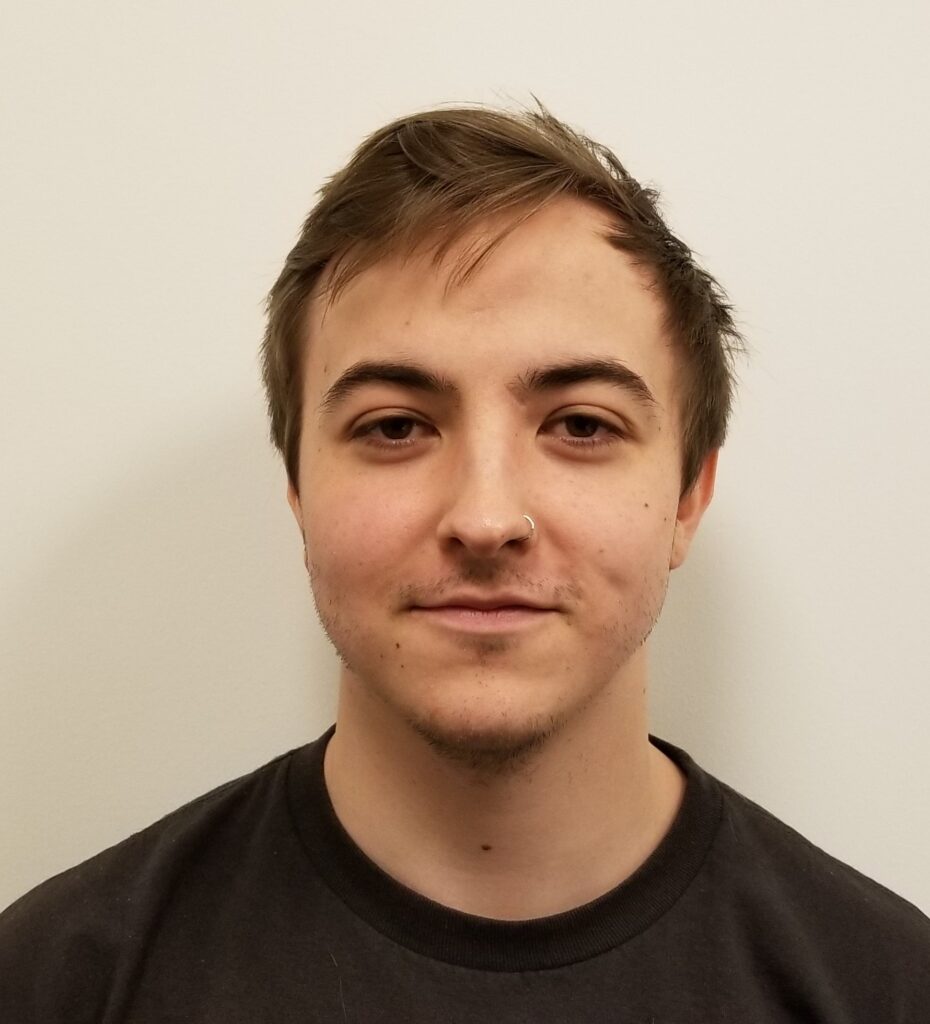
Willie awarded the Professor Walter G. Mayer Endowed Scholarship (8/2023)
Willie has been awarded the 2023-2024 Professor Walter G. Mayer Endowed Scholarship. His research explores novel materials with high magnetic anisotropy, a critical property for magnets to maintain their magnetization. Traditional high magnetic anisotropy materials contain rare-earth elements or precious metals, which face sustainability challenges. Willie is taking a new approach to explore the high entropy phase space, where new magnetic phases may be achieved by exploiting the stabilizing effect of configurational entropy. His work so far has demonstrated the feasibility of this approach in achieving high magnetic anisotropy materials. During the fellowship, he will investigate several material systems using earth-abundant elements towards magnetic recording media and permanent magnet applications that cannot be achieved by conventional means. Congratulations!
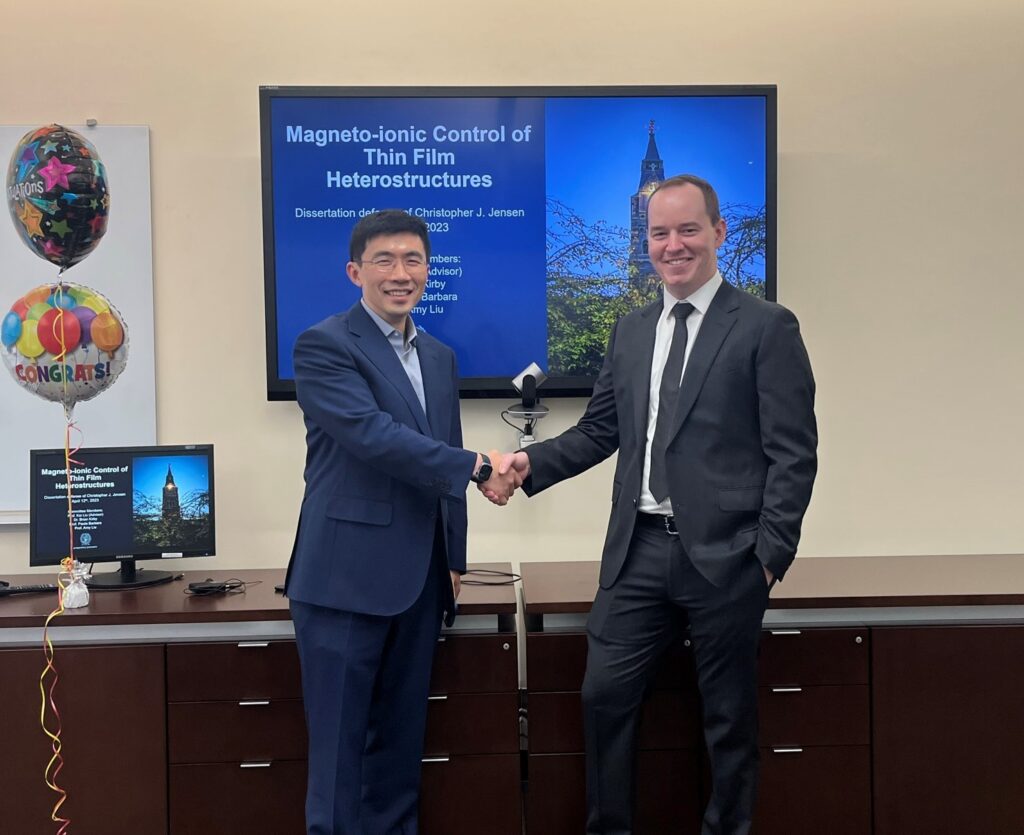
Newly minted Ph.D., Dr. Chris Jensen (4/2023)
Chris has successfully defended his Ph.D. dissertation on “Magneto-ionic control of thin film heterostructures” with distinction! He has done an impressive body of work on magneto-ionics, including ionic tuning of ferromagnetism and exchange bias in a variety of materials systems and devices. He has also made key contributions to a number of other projects on nanostructured materials. Chris is an exceptional experimentalist. Congratulations, Dr. Jensen!
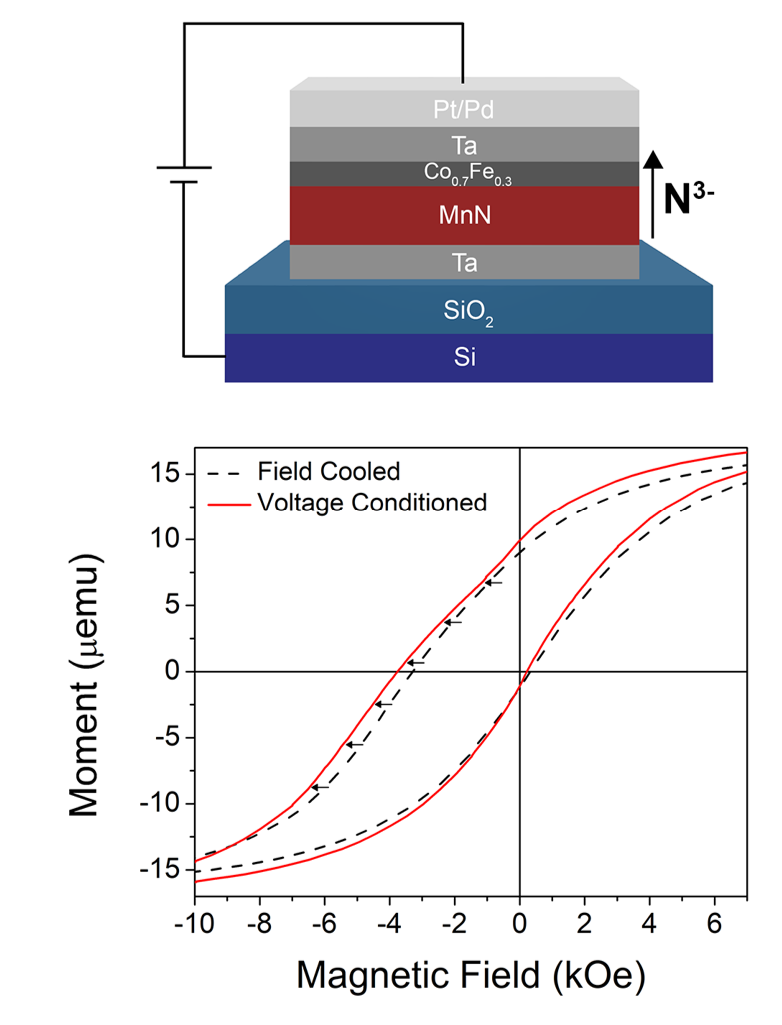
Nitrogen-based Magneto-Ionic Manipulation of Nanomagnets Demonstrated (3/2023)
Electric field control of the exchange bias effect across ferromagnet/antiferromagnet (FM/AF) interfaces has offered exciting potentials for low-energy-dissipation spintronics. In particular, the solid state magneto-ionic means is highly appealing as it may allow reconfigurable electronics by transforming the all-important FM/AF interfaces through ionic migration. In this work just published in ACS Nano, we demonstrate an approach that combines the chemically induced magneto-ionic effect with the electric field driving of nitrogen in the Ta/CoFe/MnN/Ta structure to electrically manipulate exchange bias. Upon field-cooling the heterostructure, ionic diffusion of nitrogen from MnN into the Ta layers occurs. A significant exchange bias is observed, which can be further enhanced after a voltage conditioning. This enhancement can be reversed by voltage conditioning with an opposite polarity. Nitrogen migration within the MnN layer and into the Ta capping layer cause the enhancement in exchange bias, which is observed in polarized neutron reflectometry studies. These results demonstrate an effective nitrogen-ion based magneto-ionic manipulation of exchange bias in solid-state devices. This work has been led by Chris, together with Alberto, in collaboration with our colleagues at NIST and KAUST.

Chris Jensen received the NRC Research Associateship (3/2023)
Chris Jensen has received a prestigious Fellowship from the National Research Council (NRC) Research Associateship Programs (RAP). The NRC-RAP promote excellence in scientific and technological research conducted by the U.S. government through the administration of programs offering graduate, postdoctoral, and senior level research opportunities at sponsoring federal laboratories and affiliated institutions. Chris will be conducting postdoctoral research at the NIST Center for Neutron Research to use neutron scattering to probe topological spin textures.
2022
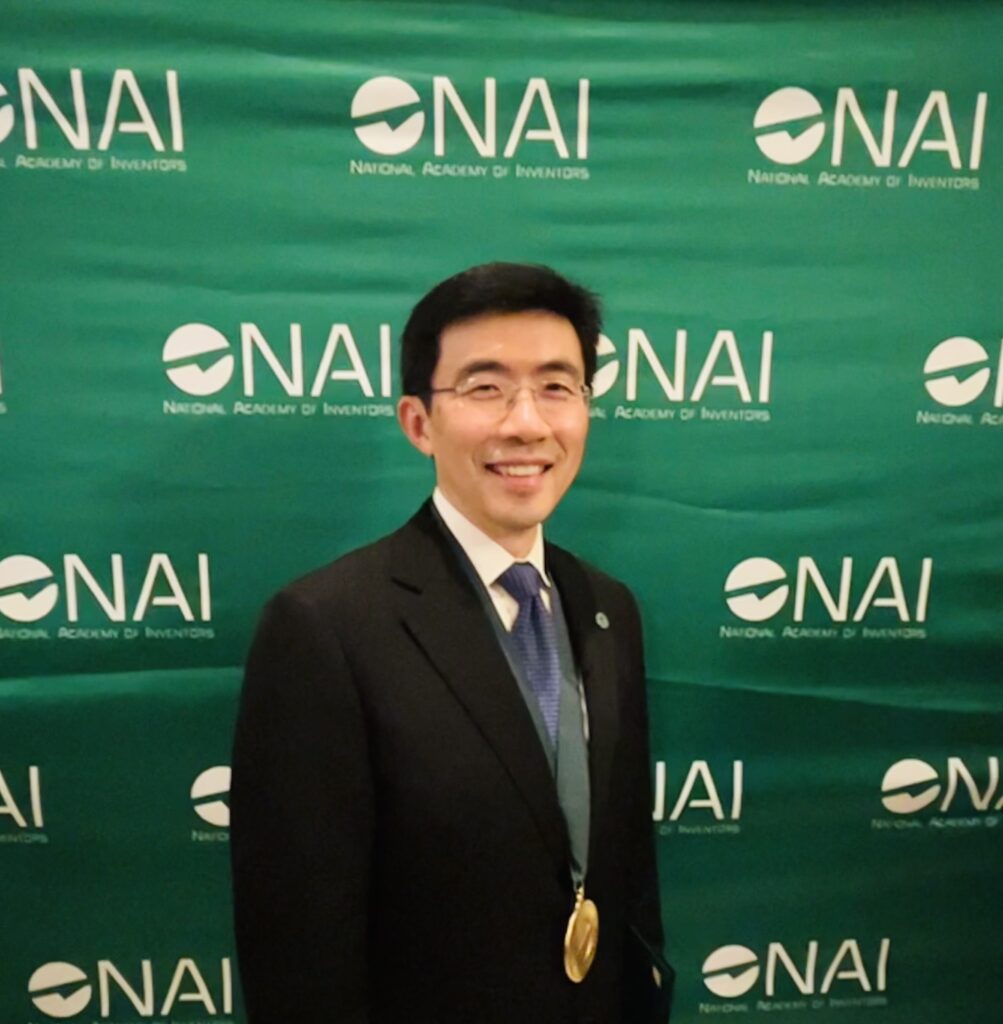
Prof. Liu elected Fellow of the National Academy of Inventors (12/2022)
Prof. Liu has been elected as Fellow of the National Academy of Inventors. This is the highest professional distinction awarded to academic inventors. It is really a recognition to the work done together with all of our students, postdocs, and collaborators. The 2022 class of Fellows will be honored and presented their medals at the 12th Annual Meeting of the National Academy of Inventors on June 27th, 2023 in Washington, DC.
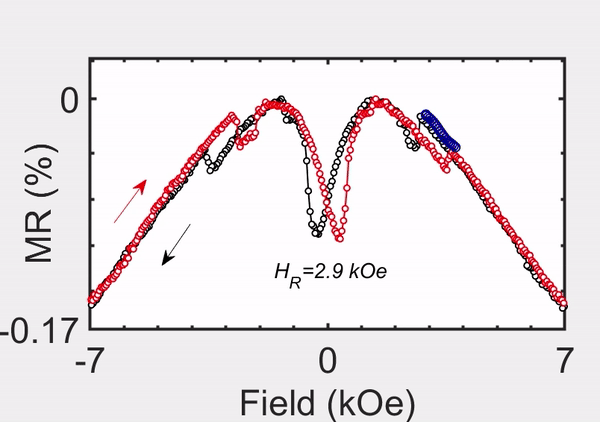
3D Interconnected Magnetic Nanowire Networks as Potential Integrated Multistate Memristors (12/2022)
Interconnected magnetic nanowire (NW) networks offer a promising platform for 3-dimensional (3D) information storage and integrated neuromorphic computing. In this work just published in Nano Letters we report discrete propagation of magnetic states in interconnected Co nanowire networks driven by magnetic field and current, manifested in distinct magnetoresistance (MR) features. Micromagnetic simulations reveal that these MR features are due to domain wall (DW) pinning at the NW intersections, which is further confirmed by off-axis electron holography imaging. First-order reversal curve measurements of MR (MR-FORC) illustrate the strong dependence of magnetization reversal on the initial magnetic state or the history in these networks. These properties are desirable to fashion non-Boolean computing devices such as spintronic memristors and synaptic devices where different resistance states or synaptic weights can be programmed by controllably switching a certain subsection of the networks. These networks may also find potential applications in reservoir and probabilistic computing, as well as physically unclonable functions.
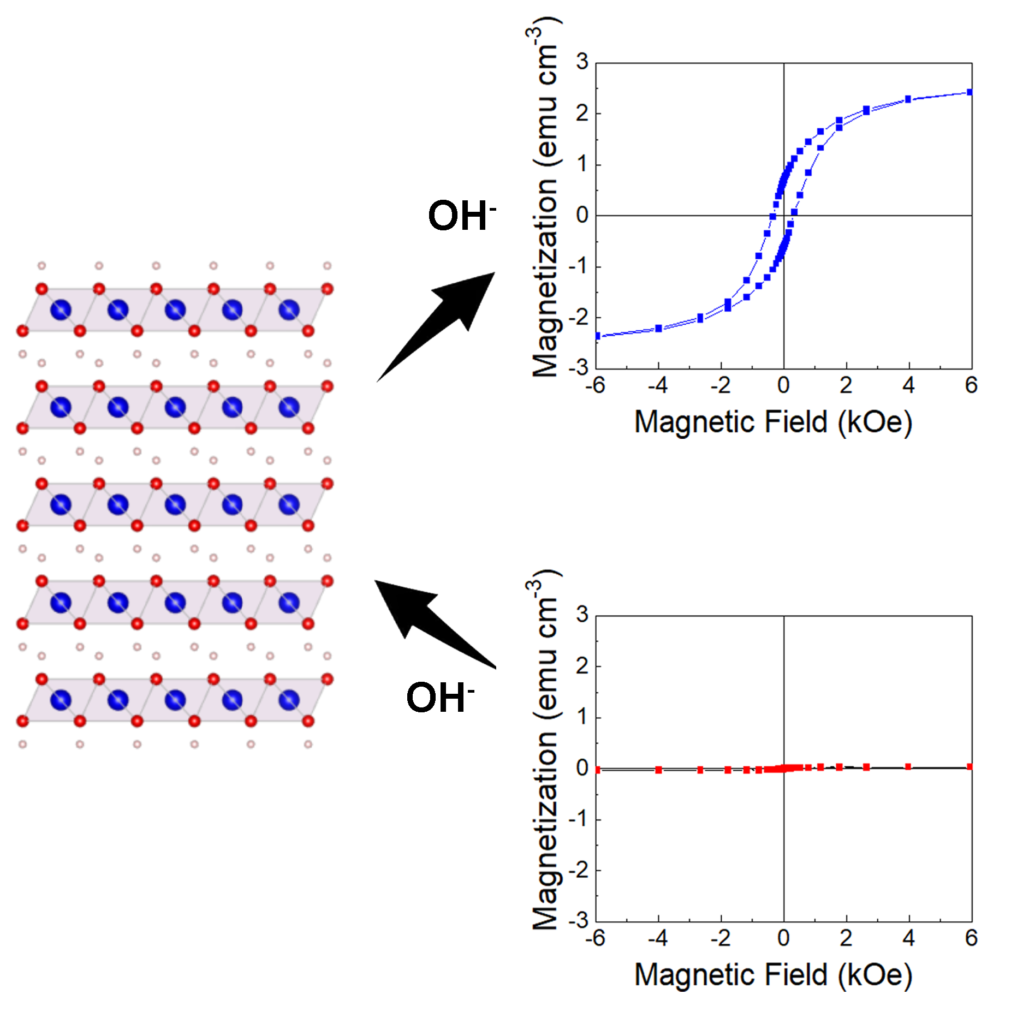
Hydroxide-based magneto-ionics (11/2022)
Magneto-ionics has emerged as a promising approach to manipulate magnetic properties, not only by drastically reducing power consumption associated with electric current based devices but also by enabling novel functionalities. To date, magneto-ionics have been mostly explored in oxygen-based systems, while there is a surge of interests in alternative ionic systems such as hydrogen and nitrogen. In this JMCC work led by Alberto, we demonstrate highly effective hydroxide-based magneto-ionics in electrodeposited alpha-Co(OH)2 films. The alpha-Co(OH)2, which is a room temperature paramagnet, is switched to ferromagnetic after electrolyte gating with a negative voltage. The system is fully, magnetically reversible upon positive voltage application. The origin of the reversible paramagnetic-to-ferromagnetic transition is attributed to the ionic diffusion of hydroxyl groups, promoting the formation of metallic cobalt ferromagnetic regions. Many thanks to the great collaboration with Xixiang’s group.
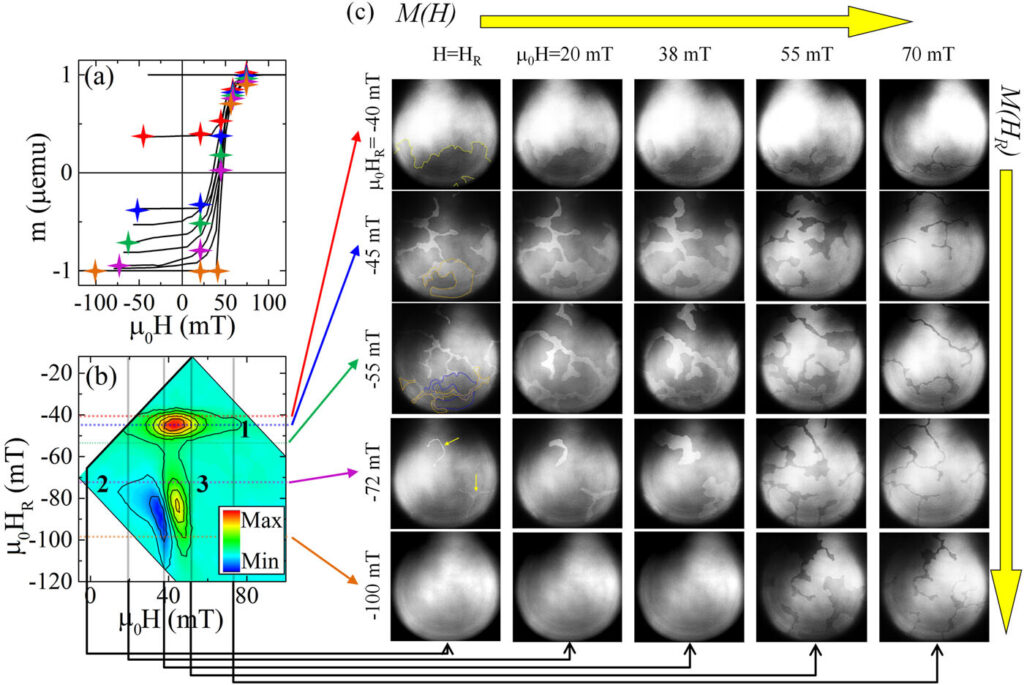
Comparing magnetometry FORC with magnetic imaging (11/2022)
The first order reversal curve (FORC) method is a macroscopic measurement technique which can be used to extract quantitative, microscopic properties of hysteretic systems. In this APL Mater. study led by Dustin, using magnetic transmission X-ray microscopy (MTXM) at LBL-ALS with Mi-Young Im and Peter Fischer, local element-specific FORC measurements are performed on a 20 nm thick film of CoTb. The FORCs measured with microscopy reveal a step-by-step domain evolution under the magnetic field cycling protocol, and provide a direct visualization of the mechanistic interpretation of FORC diagrams. They are compared with magnetometry FORCs and show good quantitative agreement. Furthermore, the high spatial resolution and element-specific sensitivity of MTXM provide new capabilities to measure FORCs on small regions or specific phases within multicomponent systems, including buried layers in heterostructures. More examples of FORC studies can be found at our FORC library.
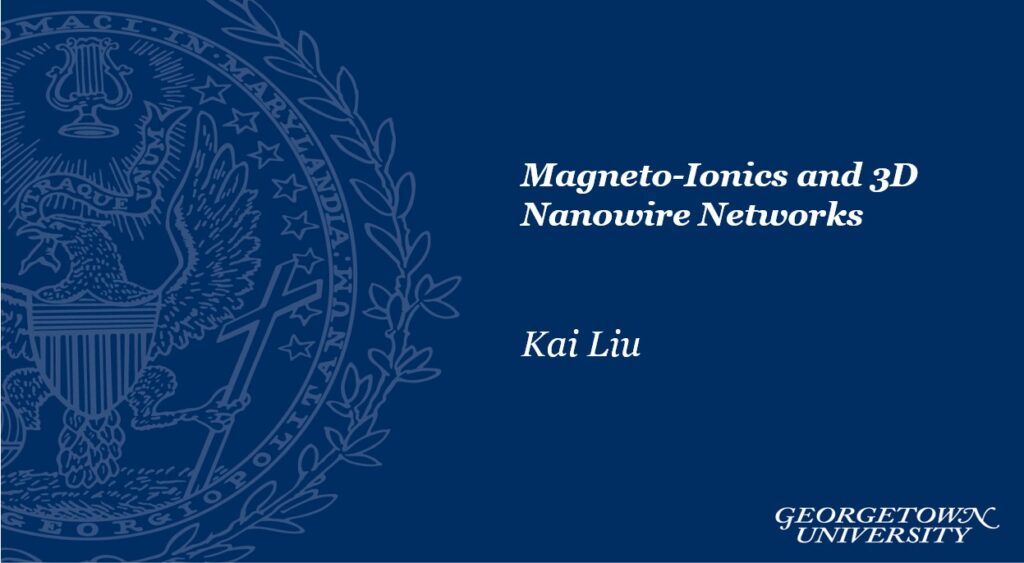
Prof. Liu delivers a Quantum Materials and Device seminar at CIQM (9/2022)
In this online seminar sponsored by the Science & Technology Center for Integrated Quantum Materials (Harvard University, Howard University, and MIT), Prof. Liu discusses latest progress in Magneto-Ionics and 3D Nanowire Networks. Many thanks to Prof. Westervelt, Dr. Yingying Wu, and the entire CIQM team!
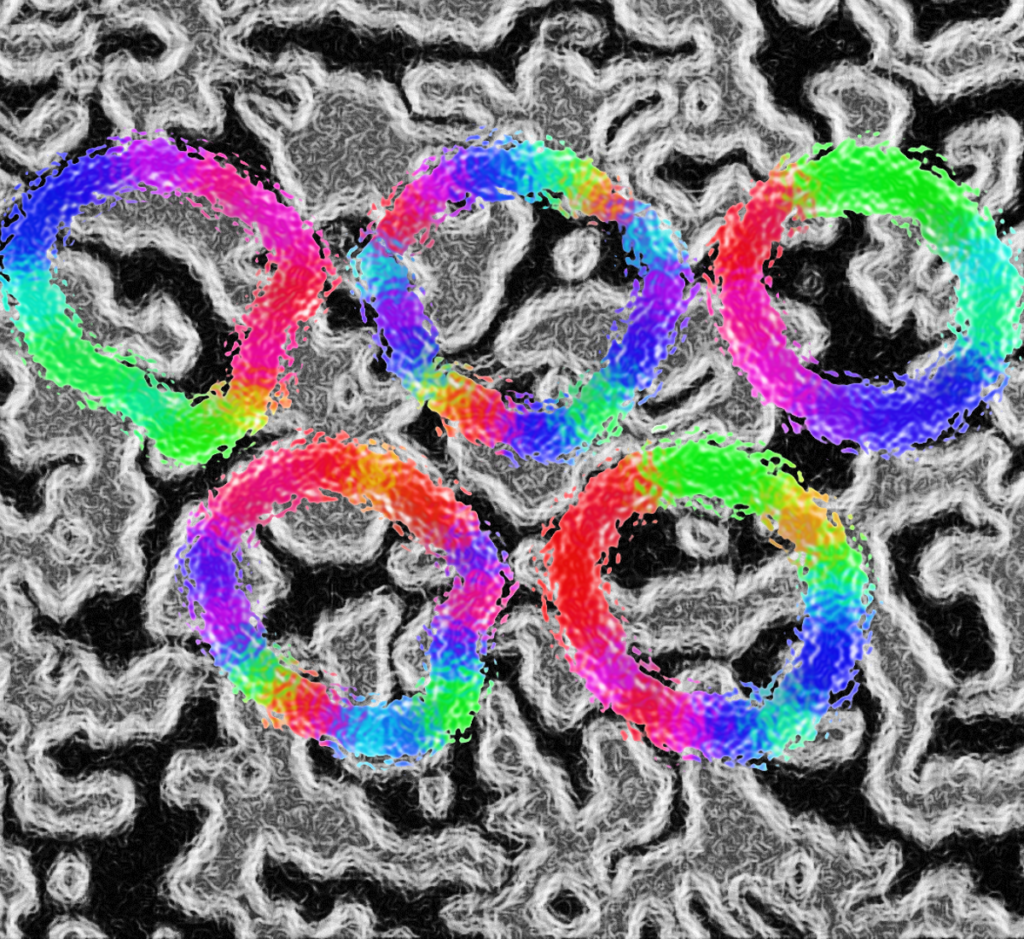
Chiral spin textures are fundamentally interesting, with promise for device applications. In this Nano Letters just published, we report an ultrasensitive chirality switching in (Ni/Co)n multilayer induced by capping with only 0.22 monolayer of Pd. Using spin-polarized low-energy electron microscopy, we monitor the gradual evolution of domain walls from left-handed to right-handed Néel walls and quantify the DMI induced by the Pd capping layer. We also observe the chiral evolution of a skyrmion during the DMI switching, where no significant topological protection is found as the skyrmion winding number varies. This corresponds to a minimum energy cost of <1 attojoule during the skyrmion chirality switching. Our results demonstrate the detailed chirality evolution within skyrmions during the DMI sign switching, which is relevant to practical applications of skyrmionic devices.

Chris receives Professor Walter G. Mayer Endowed Scholarship (6/2022)
Chris has been selected to receive the 2022-2023 Professor Walter G. Mayer Endowed Scholarship. He will explore a novel type of magneto-ionic materials to address the energy challenges in nanoelectronics. In such materials, an electric field may be used to drive ions and change the magnetic properties, leading to a reduction in Joule heating compared to electric current-based devices and allow for more functionality compared to existing technology. Congratulations!

We are selected as a Phase 2 Finalist of the Mask Innovation Challenge (3/2022)
We are excited to be selected as one of the ten finalists for Phase 2 of the BARDA-NIOSH-NIST Mask Innovation Challenge, after last year’s Phase 1 competition! See feature coverage by Science and Scientific American.
“The second phase of the Mask Innovation Challenge represents a bold step in reimagining respiratory protective devices that can protect the wearer from a variety of airborne hazards. The goal is to accelerate the development of next generation masks that have multi-hazard protection and aim to meet performance and design criteria of the Moonshot Target Product Profile.”
For further information, please see BARDA’s press release and social media post.
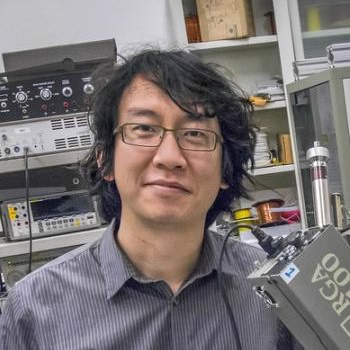
Pulling Magnetic Skyrmions out of Thin Air (3/2022)
Magnetic skyrmions are topologically nontrivial spin textures with envisioned applications in energy-efficient magnetic information storage. Toggling the presence of magnetic skyrmions via writing/deleting processes is essential for spintronics applications, which usually require the application of a magnetic field, a gate voltage or an electric current. In a study led by Gong, we have demonstrated a new, field-free method to write/delete skyrmions at room temperature via hydrogen chemisorption/desorption on the surface of Ni and Co films. Supported by Monte-Carlo simulations, the skyrmion creation/annihilation is attributed to the hydrogen-induced magnetic anisotropy change on ferromagnetic surfaces. We also demonstrate the role of hydrogen and oxygen on magnetic anisotropy and skyrmion deletion on other magnetic surfaces. Our results open up new possibilities for designing skyrmionic and magneto-ionic devices. The paper is just published in Nature Communications, and a brief summary can be found here.
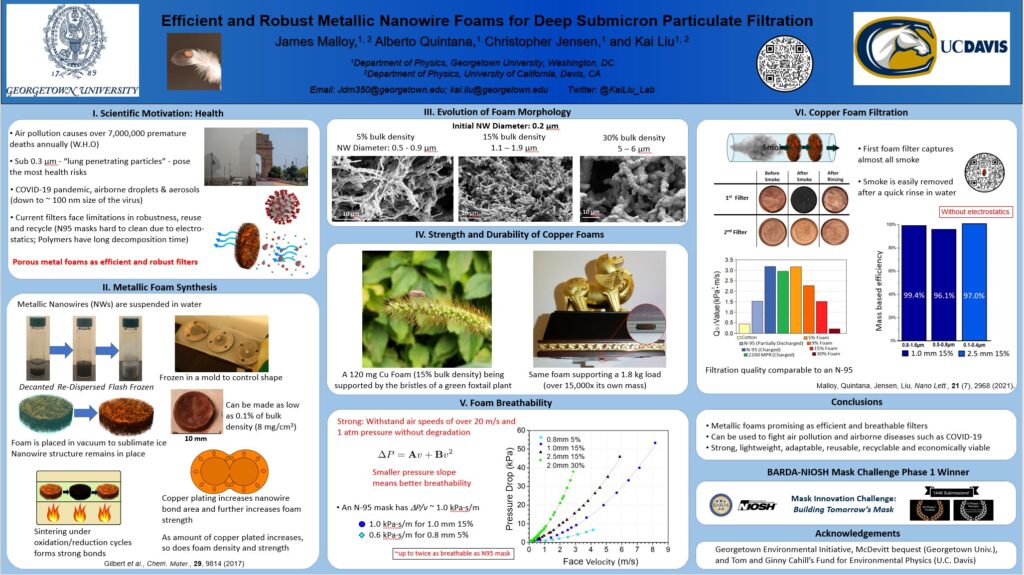
James Won 2022 AAAS Student E-Poster Award (2/2022)
James was selected as the Graduate First Place Winner of the 2022 AAAS Student E-Poster Competition in the Physical Sciences, for his presentation of “Efficient and Robust Metallic Nanowire Foams for Deep Submicron Particulate Filtration”, based on his recent publication in Nano Letters. This competition was part of the 2022 American Association for the Advancement of Science (AAAS) Annual Meeting. James and all other winners are recognized in the 3/25 issue of Science. Congratulations!
The AAAS Student E-poster competition recognizes the individual efforts of students who are actively working toward an undergraduate, graduate or doctoral-level degree. The winners’ presentations displayed originality and understanding that set them apart from their peers.
2021
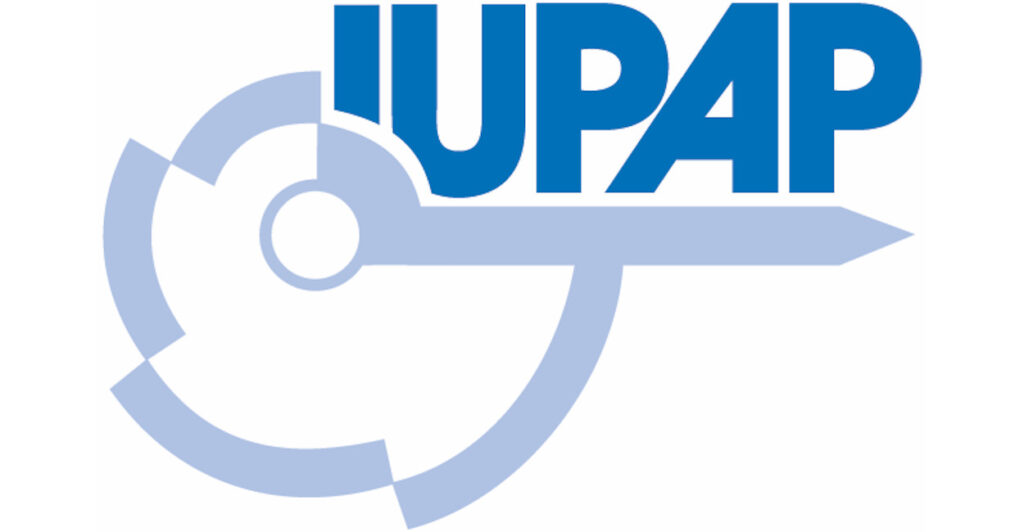
Prof. Liu elected Chair of IUPAP Commission on Magnetism (10/2021)
Professor Kai Liu has been elected Chair of the IUPAP Commission on Magnetism, at the 30th General Assembly of the International Union of Pure and Applied Physics (IUPAP). The IUPAP is an organization committed to assisting in the worldwide development of physics, fostering international cooperation in physics, and helping in the application of physics toward solving problems of concern to humanity. It was established in Brussels in 1922, and currently has 60 nation members. The Commission on Magnetism (C9) promotes the exchange of information and views, organizes conferences, and recognizes outstanding contributions in the field of magnetism. Prof. Liu was nominated by the National Academy of Sciences and the American Physical Society. He has served as Secretary of the C9 Commission, and will serve as Chair for the 2022-2024 term.
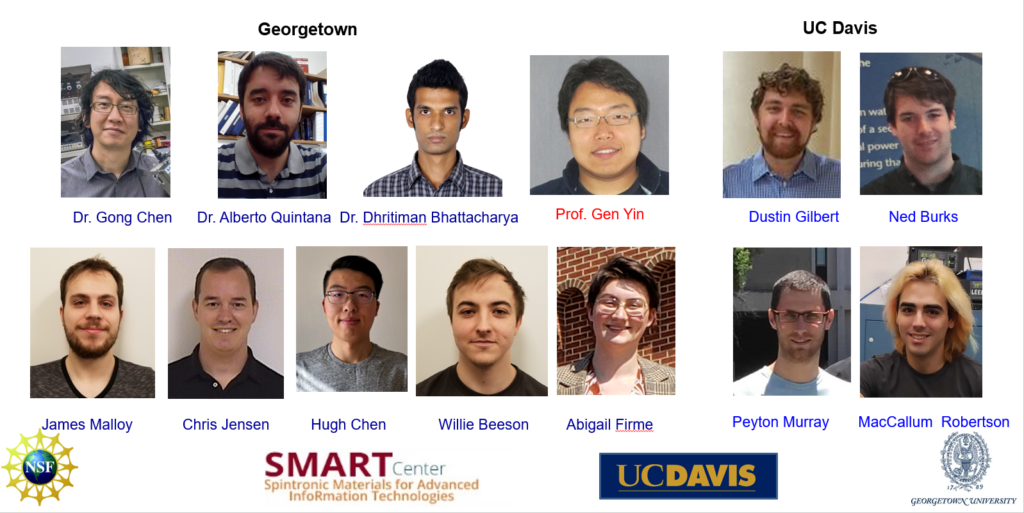
Prof. Liu delivers a Physics Department colloquium (9/2021)
This colloquium reviews our recent studies on magneto-ionics and chiral spin textures for future nanoelectronics, as well as nanoporous metallic foams for deep submicron particulate filtration, relevant for fighting COVID-19 and air pollution.
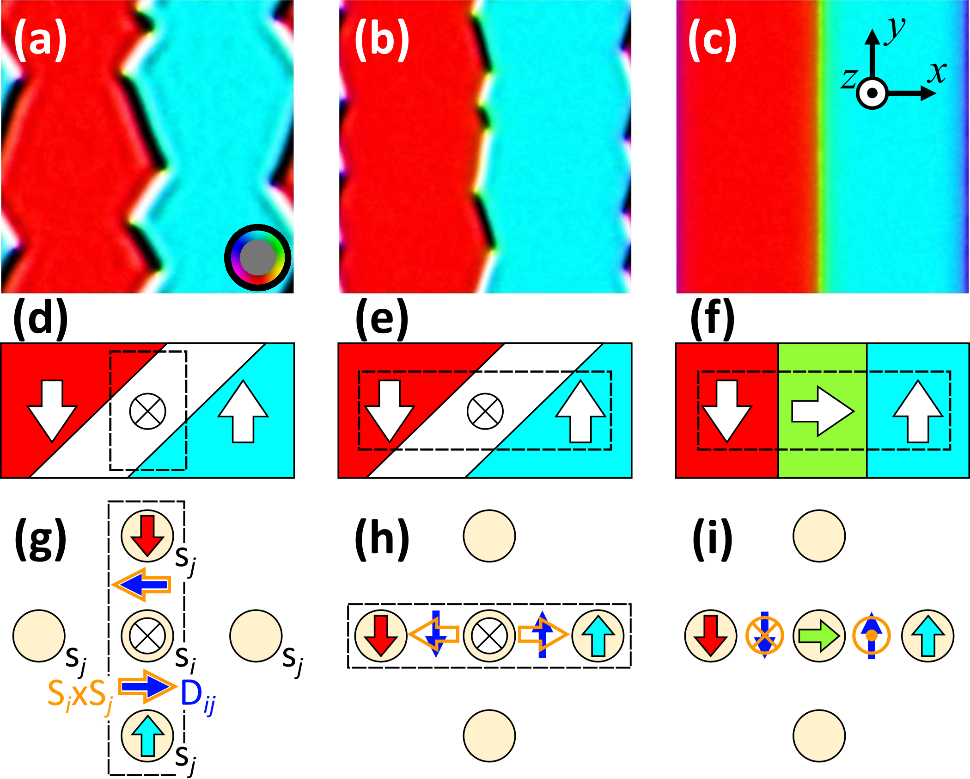
Our contribution to honor Prof. Chuck Fadley (8/2021)
We report a chirality-induced zigzag domain wall in in-plane magnetized ultrathin films of Fe/Ni/W(110) in Journal of Vacuum Science & Technology A. A novel transition of the domain wall shape from a zigzaglike pattern to straight is observed as a function of the film thickness, which is triggered by the transition of the domain wall type from the out-of-plane chiral wall to the in-plane Néel wall, and attributed to DMI contributions to the wall energy.
This work is part of a JVSTA special issue honoring Prof. Chuck Fadley. Chuck was a treasured source of wisdom and support for me and my group over nearly two decades. He is dearly missed as a top-notch scientist, a beloved colleague, and a cherished mentor.
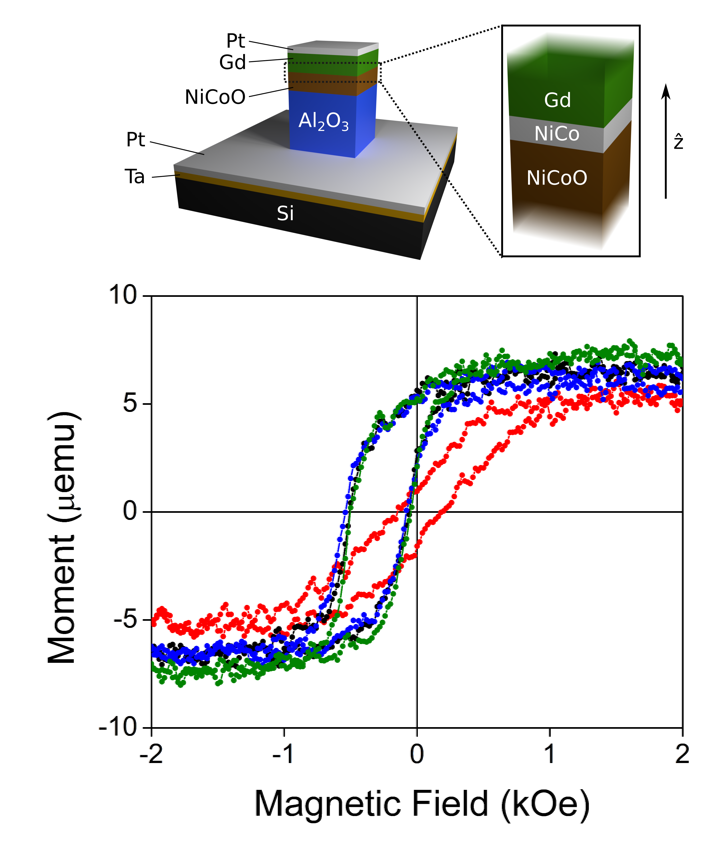
Electrically Enhanced Exchange Bias via Solid State Magneto-Ionics (8/2021)
Electrically induced ionic motion offers a new way to realize voltage-controlled magnetism, opening the door to a new generation of logic, sensor, and data storage technologies. We have demonstrated an effective approach to magneto-ionically and electrically tune the exchange bias in Gd/NiCoO thin films, where neither of the layers alone is ferromagnetic at room temperature. Ion irradiation / implantation is also used to alter the interfacial microstructure and in turn the exchange bias. These results highlight the viability of the solid-state magneto-ionic approach to achieve electric control of exchange bias, with potential for energy-efficient magneto-ionic devices. The studies are published in ACS Applied Materials and Interfaces and Journal of Magnetism and Magnetic Materials.
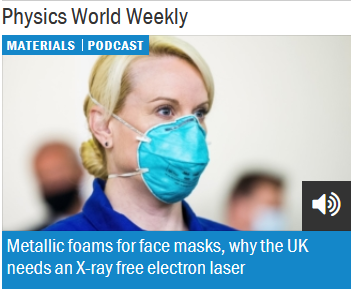
Podcast with Physics World (7/2021)
Really appreciate this opportunity to do a podcast with Dr. Margaret Harris and Physics World on our nanoporous metal foam work. Hear the discussions on our motivations and how we got started, features of copper foams as effective filtration media, the BARDA-NIOSH Mask Innovation Challenge, and our next steps, starting at ~ 16 min mark of the podcast. Our thanks also to Dr. Isabelle Dumé for coverage on our publication earlier.
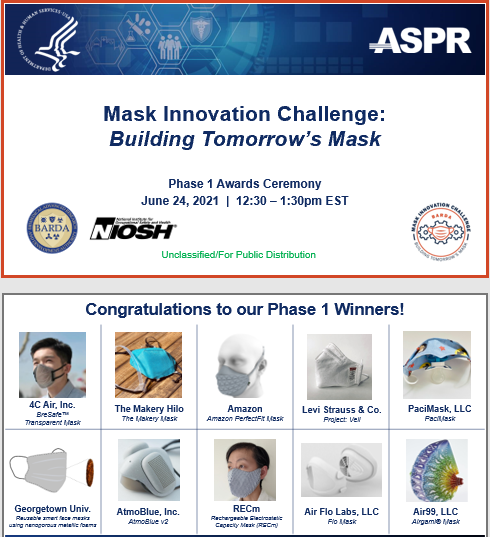
Phase 1 Winner of the BARDA-NIOSH Mask Innovation Challenge (6/2021)
We are thrilled to be selected as one of the ten Phase 1 winners of the BARDA – NIOSH Mask Innovation Challenge, out of 1448 submissions. Kudos to all participants for improving the mask design, and congratulations to all the winning teams! Our design is a new type of air filtration material based on lightweight nanoporous metal foams that are efficient, breathable, robust, adaptable, cost-effective, and can also be cleaned, reused and recycled. Feasibility demonstration was published recently in Nano Letters, and featured by ACS. Huge thanks to BARDA, NIOSH and the Accelerator Network teams and judges for organizing this Challenge! We’ve learned a lot from this community, hope to keep engaged, advance our foam designs and contribute to the fight against COVID-19, future pandemics, and air pollution. Read Georgetown University coverage here and in Common Home. The Awards Ceremony can be viewed here.
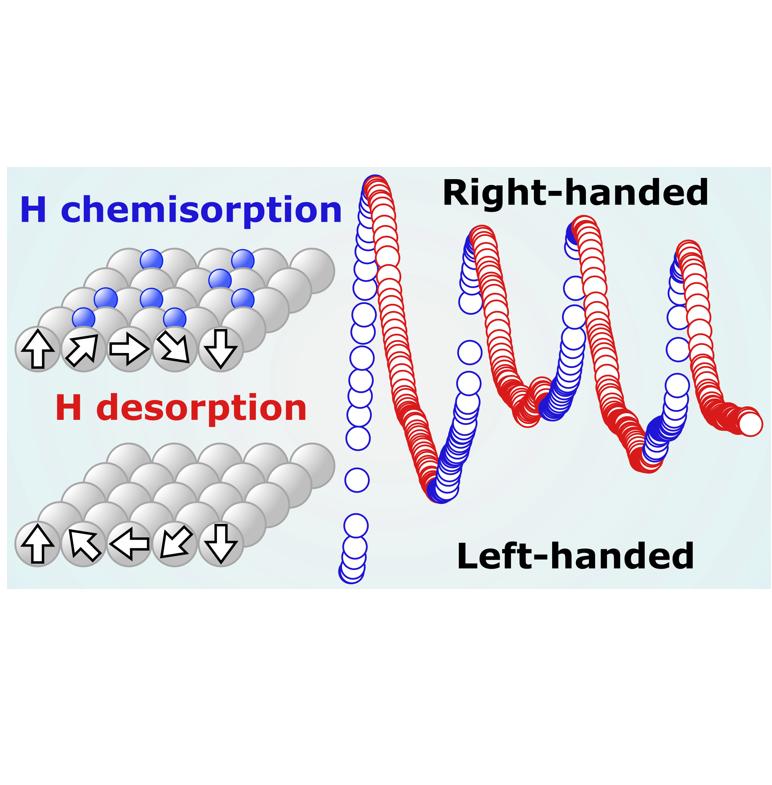
Hydrogen-induced Dzyaloshinskii-Moriya interaction and reversible switching of magnetic chirality (4/2021)
We demonstrate a fundamentally new way to induce the DMI, a handle to introduce topology into real-space magnetic configurations: Adsorption of hydrogen onto a ferromagnetic surface not only instigates the interaction but also allows us to dial its strength up or down on demand, and switch the magnetic chirality of domain walls. These results shed new light on the understanding of DMI in low atomic number materials and design of novel chiral spintronics and magneto-ionic devices. This work, led by Gong, together with Mac and the rest of the team, is published in PRX.
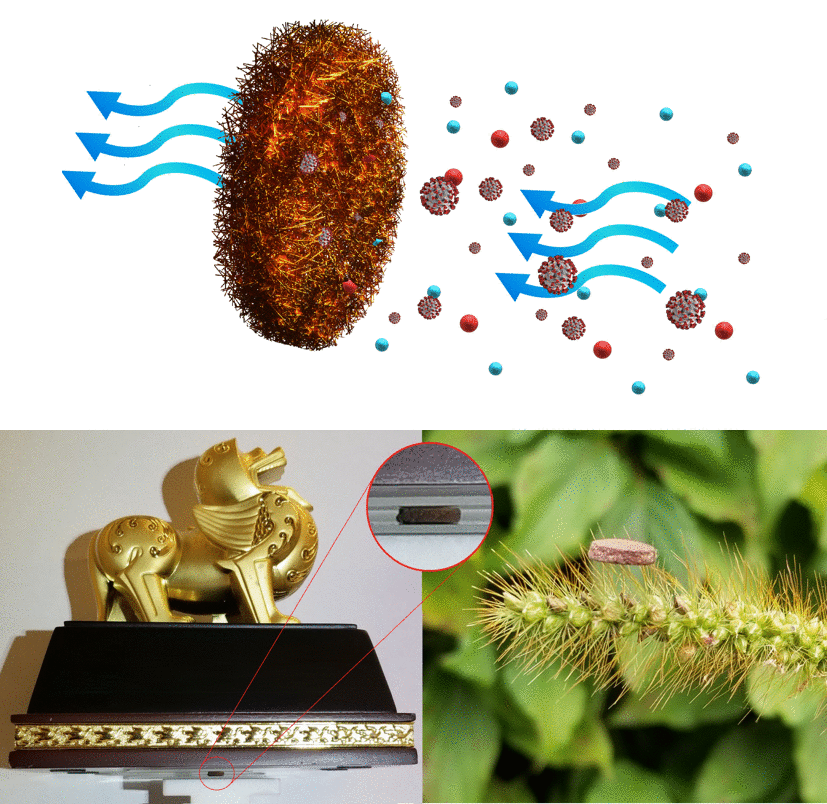
Efficient and Robust Metallic Nanowire Foams for Deep Submicron Particulate Filtration (3/2021)
We have demonstrated light weight nanowire-based metal foam filters that are highly efficient, durable, reusable and recyclable, particularly for deep submicron airborne particulates. They combine extremely large surface areas with excellent mechanical properties. This is relevant for combating COVID-19 as well as air pollution. This work, led by James, together with Alberto and Chris, is published in Nano Letters, and featured by the American Chemical Society in its news release, The Academic Times, Physics World, and others. This study was initiated in 2016 at U. C. Davis by a generous gift from my late colleague Tom Cahill, along with his wife Ginny, which steered us into this direction, and continued at Georgetown with support from the Georgetown Environmental Initiative and the McDevitt bequest. Tom had two distinguished careers, first in Physics and then in Environmental Science (particularly air pollution) after his official retirement. He was our inspiration for this project.
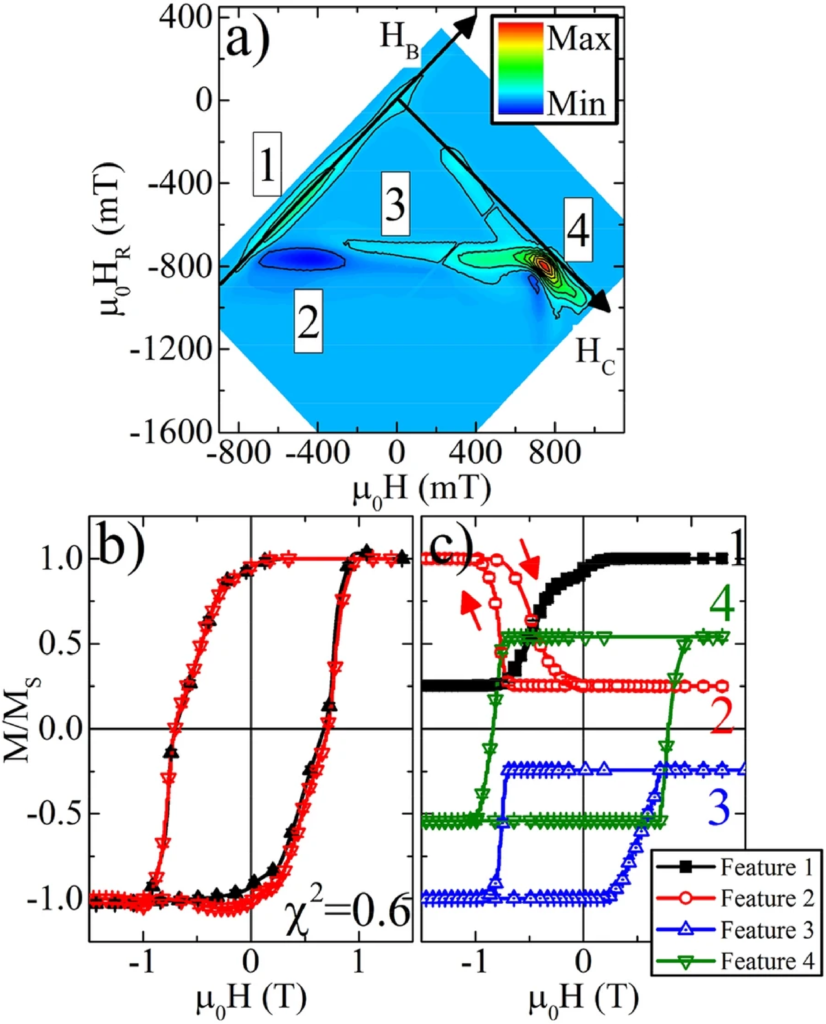
Reconstructing phase-resolved hysteresis loops from FORC (2/2021)
The first-order reversal curve (FORC) method is powerful in resolving coexistence of multiple magnetic phases from ensemble-averaged hysteresis loops, as separate features in the FORC distribution. Now the reverse is possible. In this Scientific Reports study led by Dustin, we show that phase-resolved hysteresis loops can be reconstructed from FORC.
2020
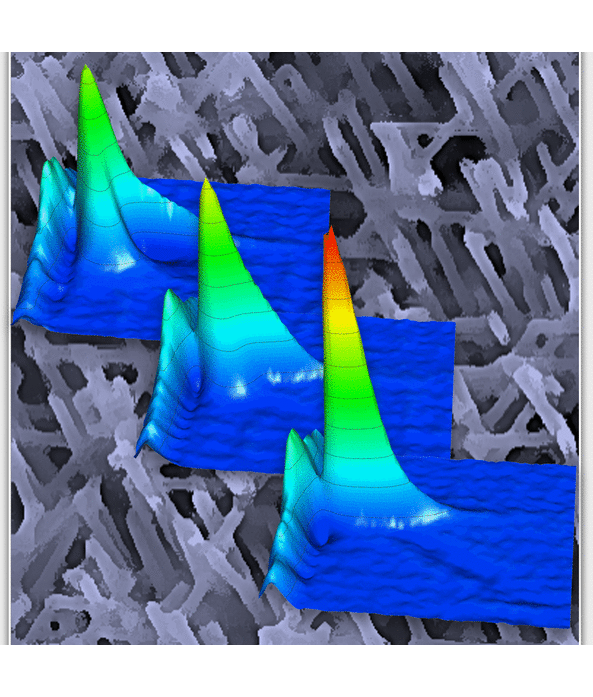
3D Nanomagnetism Explored in Low Density Interconnected Nanowire Networks (12/2020)
Our study on 3D nanomagnetism in quasi-ordered metallic nanowire networks is published in Nano Letters, led by Ned and Dustin. “Magnetic fingerprints” of the networks are captured by the FORC method, illustrating potentials for 3D information storage and neuromorphics.
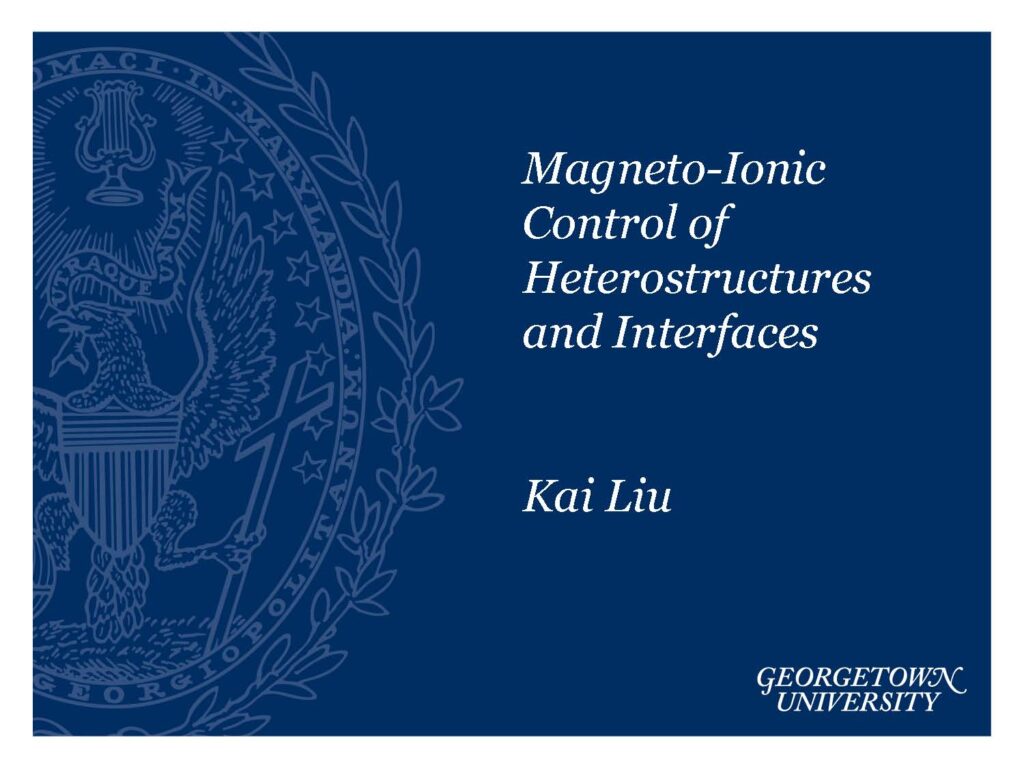
Prof. Liu delivers online spintronics seminar (10/2020)
Check out this presentation of our recent studies on magneto-ionics. Grateful to all our colleagues and collaborators. Thanks to Prof. Xin Fan and Prof. Kirill Belashchenko for organizing the seminar series!
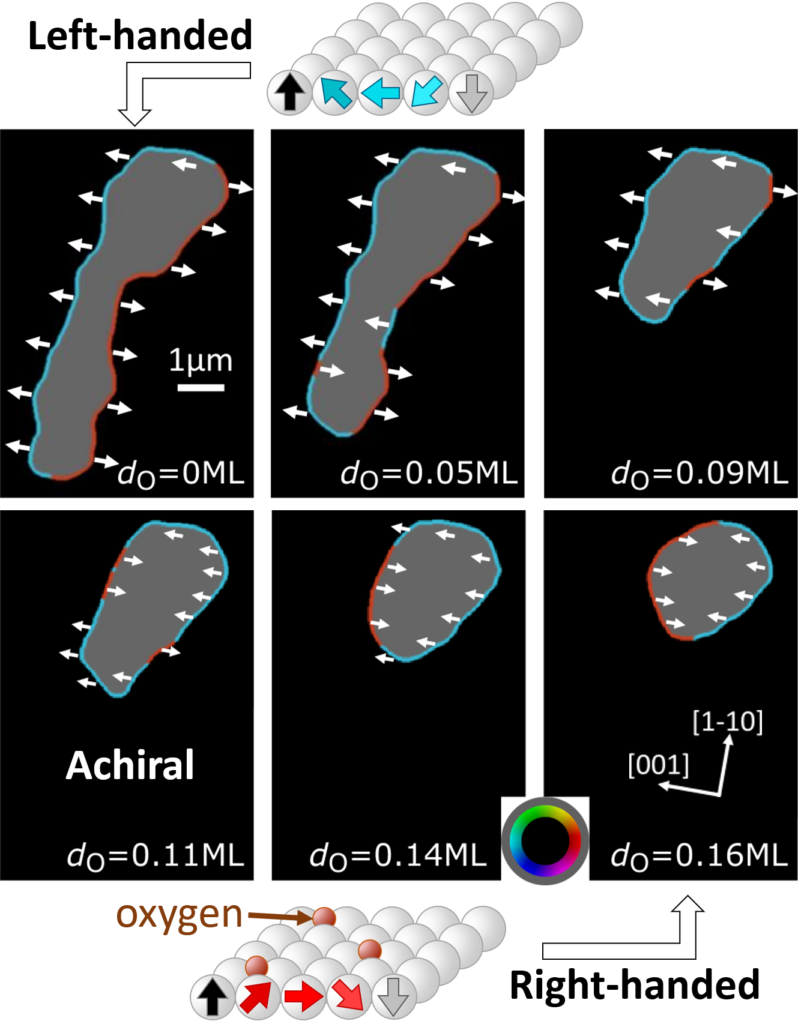
Large DMI induced by chemisorbed oxygen on a ferromagnet surface (8/2020)
Our study on chemisorbed oxygen induced DMI on ferromagnet surface is published in Science Advances. This can be used to stabilize chiral domain walls and magnetic skyrmions. Congratulations to Gong, Mac, and team!
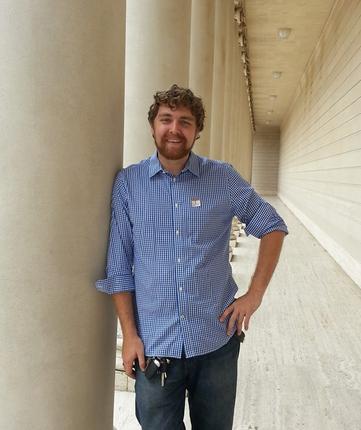
Dustin wins prestigious DOE CAREER Award (6/2020)
Our lab alumnus, Dustin Gilbert, now an Assistant Professor of Materials Science and Engineering at the University of Tennessee, Knoxville, has won the prestigious DOE Early Career Award! He will explore “Exotic Uses of Neutrons an X-rays as Probes for Chiral Magnets” for this award. Congratulations, Dustin!

Hugh coauthors paper in Nature Nanotechnology (5/2020)
In collaboration with colleagues at the University of California, Davis and our lab alumnus Dustin Gilbert, Hugh has studied novel nanoscale magnetic probes for enhanced contrast in a two-way magnetic resonance tuning method. The work is published in Nature Nanotechnology.
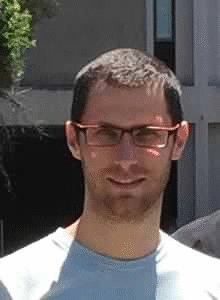
Peyton demonstrates ionic tuning of superconductivity in YBCO (1/2020)
This work demonstrates an effective approach for ionic tuning of superconductivity in cuprates, an interface induced effect that goes well into the quasi-bulk regime. The work is published in ACS Applied Materials & Interfaces.
2019
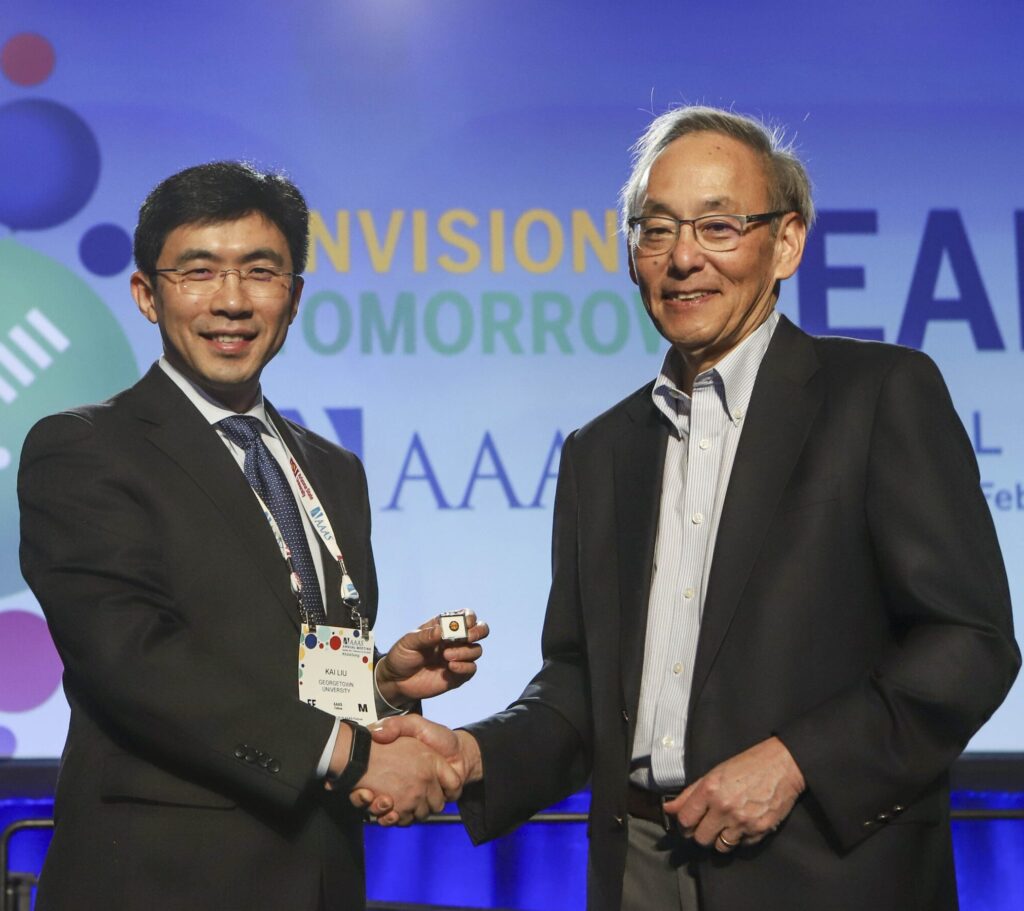
Prof. Kai Liu elected Fellow of the American Association for the Advancement of Science (11/2019)
He is being recognized “for distinguished contributions to the field of nanomagnetism and spintronics, particularly for understanding of magnetic materials and nanostructures.” He is one of 27 members elected from the AAAS Section on Physics in 2019.
Picture: with AAAS President Steve Chu at the Fellows Forum of the 2020 AAAS Annual Meeting, Seattle, WA, 2/15/2020. Credit: Robb Cohen Photography & Video
Gong Chen Wins the LBL 2019 NanoArt Image Contest (10/2019)
Gong’s SPLEEM image won the 2019 NanoArt Image Contest of the Lawrence Berkeley Laboratory Molecular Foundry, as part of their National Nano Day celebration. It was chosen as the 1st place, Foundry’s Choice.
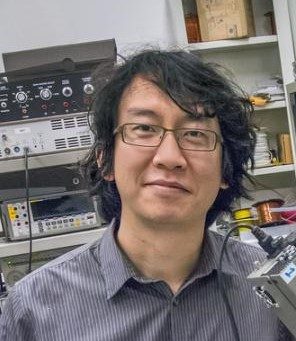
Gong Chen’s Work Recognized in Magnetism as Art Showcase (1/2019)
Gong was recognized as a finalist for the “Magnetism as Art Showcase” at the 2019 Joint MMM-Intermag Conference held in Washington, DC, January 2019. Gong’s submission is an image of magnetic domains in a multilayer thin film.
2018
This NSF-DMR workshop brought together leading experts in the field to highlight scientific opportunities that may address the energy challenges in nanoelectronics in general, as symbolized by the coming end of Moore’s law.
Liu to Lead Team in Nanoelectronics Research Center (10/2018)
Liu is a theme leader in a major research center on nanoelectronic computing research led by the University of Minnesota. The Center for Spintronic Materials in Advanced Information Technologies (SMART) will focus on fundamental research on novel materials and devices with the potential to significantly advance the field of nanoelectronic computing.
Georgetown Team awarded a NSF-MRI grant (8/2018)
The GU team, led by Liu (PI), has received a grant from the NSF-MRI program for the acquisition of a state-of-the-art magnetic characterization instrument known as the Magnetic Property Measurement System (MPMS3).

Gong’s paper published in Nature Materials (5/2018)
Gong Chen’s SPLEEM study on significant DMI at graphene/ferromagnet interface published in Nature Materials.